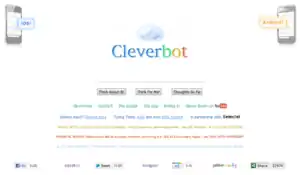Cleverbot
Cleverbot is a chatterbot web application that uses an artificial intelligence (AI) algorithm to have conversations with humans. It was created by British AI scientist Rollo Carpenter. It was preceded by Jabberwacky, a chatbot project that began in 1986 and went online in 1997.[1] In its first decade, Cleverbot held several thousand conversations with Carpenter and his associates. Since launching on the web, the number of conversations held has exceeded 150 million.[2] Besides the web application, Cleverbot is also available as an iOS, Android, and Windows Phone app.[3]
 | |
Type of site | Chatterbot |
|---|---|
| Created by | Rollo Carpenter |
| URL | www |
| Registration | None |
| Current status | Active |
Operation
Unlike some other chatterbots, Cleverbot's responses are not pre-programmed. Instead, it learns from human input: Humans type into the box below the Cleverbot logo and the system finds all keywords or an exact phrase matching the input. After searching through its saved conversations, it responds to the input by finding how a human responded to that input when it was asked, in part or in full, by Cleverbot.[4][5]
Cleverbot participated in a formal Turing test at the 2011 Techniche festival at the Indian Institute of Technology Guwahati on 3 September 2011. Out of the 1334 votes cast, Cleverbot was judged to be 59.3% human, compared to the rating of 63.3% human achieved by human participants. A score of 50.05% or higher is often considered to be a passing grade.[6] The software running for the event had to handle just 1 or 2 simultaneous requests, whereas online Cleverbot is usually talking to around 10,000 to 50,000 people at once.[7]
Developments
Cleverbot is constantly growing in data size at a rate of 400 to 7 million interactions per second. Updates to the software have been mostly behind the scenes. In 2014, Cleverbot was upgraded to use GPU serving techniques.[8] Unlike Eliza, the program does not respond in a fixed way, instead choosing its responses heuristically using fuzzy logic, the whole of the conversation being compared to the millions that have taken place before. Cleverbot now uses over 279 million interactions, about 3-4% of the data it has already accumulated. The developers of Cleverbot are attempting to build a new version using machine learning techniques.[9]
A significant part of the engine behind Cleverbot and an API for accessing it has been made available to developers in the form of Cleverscript. A service for directly accessing Cleverbot has been made available to developers in the form of Cleverbot.io.[10]
An app that uses the Cleverscript engine to play a game of 20 Questions, has been launched under the name Clevernator. Unlike other such games, the player asks the questions and it is the role of the AI to understand, and answer factually. An app that allows owners to create and talk to their own small Cleverbot-like AI has been launched, called Cleverme! for Apple products.[11]
In early 2017, a Twitch stream of two Google Home devices modified to talk to each other using Cleverbot.io garnered over 700,000 visitors and over 30,000 peak concurrent viewers.[12][13][14][15]
In popular culture
In late 2010, Cleverbot received widespread media attention after being featured in the popular creepypasta ARG web serial Ben Drowned by Alexander D. Hall.[16][17][18]
See also
References
- "About the Jabberwacky AI". www.jabberwacky.com. Archived from the original on 7 January 2017. Retrieved 7 January 2017.
The whole thing started way back in 1986, and went on the web in 1997.
- Gilbert, R. L., & Forney, A. (2015). Can avatars pass the Turing test? Intelligent agent perception in a 3D virtual environment. International Journal of Human-Computer Studies, 73, 30-36
- "Cleverbot". Cleverbot.com. Retrieved 14 January 2013.
- Saenz, Aaron (13 January 2010). "Cleverbot Chat Engine Is Learning From The Internet To Talk Like A Human". Singularity Hub. Retrieved 6 June 2011.
- "Rollo Carpenter". Technische. Indian Institute of Technology Guwahati. Archived from the original on 27 November 2011. Retrieved 13 November 2011.
- Aron, Jacob (6 September 2011). "Software tricks people into thinking it is human". New Scientist. Retrieved 13 November 2011.
- https://www.cleverbot.com/human Article in 'Cleverbot'
- "Parallel Processing on Graphics Cards - Existor.com - Cleverbot". Existor.com. 5 February 2014. Retrieved 9 June 2014.
- "Cleverbot Data for Machine Learning – Existor". www.existor.com. Retrieved 30 November 2016.
- "Cleverbot.io - Cloud based Cleverbot". cleverbot.io. Retrieved 7 January 2017.
- "Cleverme! on the App Store on iTunes". iTunes. Retrieved 24 March 2014.
- Moon, Mariella (7 January 2017). "Two Google Home bots engage in a duel of words". Engadget. Retrieved 7 January 2017.
- "seebotschat - Twitch". Retrieved 7 January 2017.
dependency.list(); >> cleverbot.com
- Rossignol, Derrick (6 January 2017). "Two Google Homes are Having a Bizarre and Fascinating Conversation on Twitch". Nerdist. Archived from the original on 8 January 2017. Retrieved 7 January 2017.
Twitch user seebotschat got Cleverbot, an artificial intelligence chatbot that’s been online since 1996, running on two units...
- Bader, Daniel (6 January 2017). "Watching two Google Homes trying to have a conversation is the best thing you'll see today". Android Central. Retrieved 7 January 2017.
Twitch channel seebotschat have managed to whip together a Cleverbot API hook that keeps the units speaking...
- Van Allen, Eric (26 October 2017). "The Zelda Ghost Story That Helped Define Creepypasta". Kotaku.
- Good, Owen (9 November 2010). "The Haunting Of A Majora's Mask Cartridge". Kotaku.
- Conlon, Liam (28 June 2019). "Zelda Is at Its Best When It Embraces Horror". Vice.
